Celestial Mystery Machine
High-energy gamma rays and cosmic rays flood the heavens and shower the earth. But where do they come from, and what can they tell us about our galaxy and the universe beyond?
- Craig Tyler, Editor

On the slopes of Pico de Orizaba, the highest peak in Mexico and third highest in North America, lies the newest addition to the astronomical community’s suite of world-class observatories. At an elevation of 13,500 feet, the High-altitude Water Cherenkov Observatory, or HAWC, is ideally situated to witness upper-atmosphere events known as air showers—cascades of subatomic particles and photons of electromagnetic radiation produced whenever a highenergy gamma ray or cosmic ray hits our atmosphere. By observing air showers, HAWC indirectly observes gamma and cosmic rays.
Among more than 100 scientists from more than 30 institutions in the United States and Mexico, Los Alamos astrophysicist Brenda Dingus is the HAWC operations manager and lead investigator on several of its scientific grants. For her, payday has arrived—or at least, payoff day: the HAWC observatory, nearly 20 years in the making (if you count its smaller predecessor observatory in New Mexico), began full-scale science operations in March. It is now the world’s most sensitive, continuously running, wide-field, teraelectronvolt (TeV, or trillion electronvolt energy scale) astronomical observatory.
“HAWC sees about one-sixth of the sky at every instant and covers two-thirds of the sky during the course of the earth’s daily rotation,” explains Dingus. “And unlike most gamma-ray observatories that came before, it runs day and night, rain or shine, nearly 100 percent of the time, with excellent high-energy sensitivity. We are virtually guaranteed to make new discoveries.”
What kinds of discoveries? In some ways, the sky’s the limit. The gamma rays observable to HAWC, ranging in energy from less than a tenth of a TeV to more than a hundred TeV, are expected to shed light on astrophysical processes in sources ranging from the local (nearby pulsars) to the distant (blazar galaxies), from the well-known (supernova remnants) to the purely theoretical (microscopic black holes), and from the ultra-bright (gamma-ray bursts) to the utterly invisible (dark matter). As for high-energy cosmic rays, HAWC can help answer the hundred-year mystery of exactly where they come from. Uncovering what secrets the jumbled rain of high-energy particles and photons above may harbor is now just a matter of time, talent, and tenacity.
Mystery rays
The universe is awash in unseen radiation, and optical telescopes alone give us an incomplete picture. Radio telescopes reveal exotic new objects like pulsars and quasars not always visible in ordinary light and x-ray telescopes show us the high-temperature environment of galaxy clusters and black holes. But there is an even higher-energy world out there, requiring other specialized telescopes to see it: the world of gamma rays and cosmic rays. And unlike optical, radio, x-ray, and all the rest, with gamma and cosmic rays, it’s often unclear what’s making them.
Part of the problem is the nature of the radiation itself. Gamma rays are the highest-energy variety of light and are difficult to detect; ordinary optical components won’t do the trick. And even though the rays travel in a straight line from their astronomical source, gamma-ray instruments are less precise than those used for other wavelengths of light when resolving the location of a source. In addition, gamma-ray sources are sometimes diffuse, spread out across the light years. Other times, the sources are tiny, distant dots, shining more brightly than anything else in the known universe— but only for a few seconds, then they’re gone.

Cosmic rays, meanwhile, are subatomic particles like protons and electrons, rather than photons of light, but their electrical charges cause them to turn whenever they pass through magnetic fields. Since magnetic fields are oriented every which way throughout the universe, cosmic rays take a complex, loopy path before finding their way to a detector on Earth. The distance between the Sun and the next closest star is thousands of times greater than the average radius of curvature for a TeV cosmic-ray proton in our galactic neighborhood. So it’s never evident where a given TeV cosmic ray originated, even if it was just next door.
The sources of gamma and cosmic rays are not only difficult to make out in a technical sense, but also in a theoretical sense. Both forms of radiation extend to extraordinarily high energies, and it’s not a simple matter to identify how they obtain those energies. A million-degree neutron star, for example, is known to produce an x-ray glow in the same manner that a thousand-degree hunk of metal produces a red glow. Yet there are no known astrophysical objects with temperatures high enough—not even close—to produce an equivalent TeV gamma-ray glow. And cosmic rays are more vexing still. To produce the most energetic cosmic ray yet observed, the universe had to somehow concentrate the energy of a 60-mph baseball into a single proton. However, perhaps fortunately, the gamma- and cosmic-ray mysteries go hand in hand.
“Anything capable of accelerating very high-energy cosmic rays will also likely produce gamma rays,” says Dingus. “That means gamma-ray observations can help identify both gamma-ray and cosmic-ray sources.”
But the two forms of very-high-energy radiation have something else in common, too; air-shower detectors like HAWC are triggered equally well by both of them. So a critical first step is to learn to distinguish between the two varieties of air shower, which turns out to be an enormous challenge. At HAWC’s altitude, there are about 20,000 observable air showers per second, but only about 1000 per day are triggered by gamma rays; the rest are triggered by cosmic rays. That makes gamma rays extremely difficult to identify amidst the overwhelming cosmic-ray background.
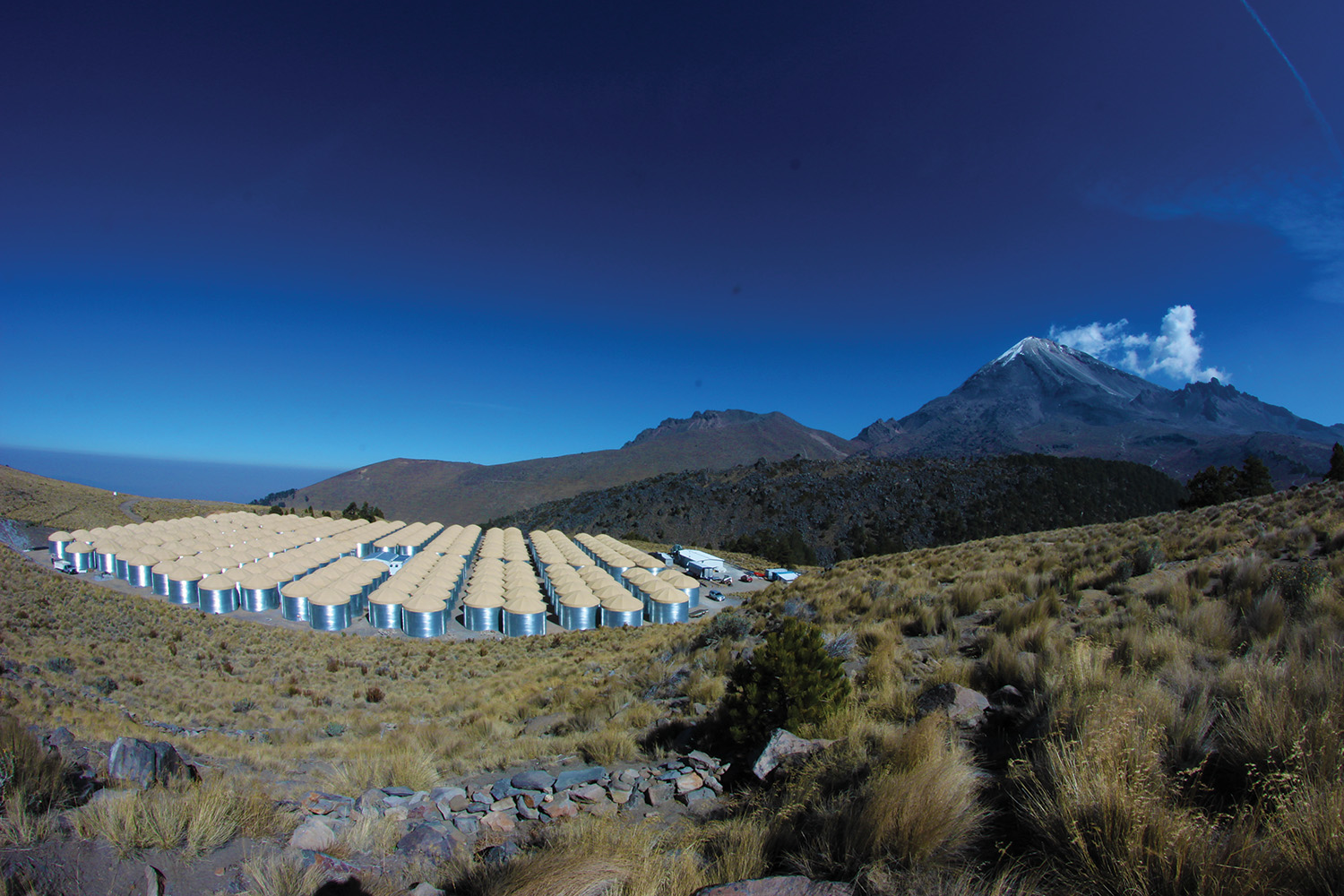
300 new eyes on the skies
An air shower begins when an incoming particle or photon collides with the nucleus of an atom in the atmosphere. In the case of a gamma-ray photon, the collision induces a process called pair production, converting the photon into two particles, a negatively charged electron and its positively charged antimatter twin, called a positron. Each of these will subsequently radiate another gammaray photon as it passes through the atmosphere, and those photons will again undergo pair production, and so on. At every stage, this electromagnetic cascade divides up the initial photon’s energy among more particles, spreading out in an ever-wider shower.
HAWC is comprised of 300 massive tanks of pure, clear water, and at the bottom of each tank is a set of four photomultiplier tubes (PMTs), which are essentially optical cameras with exceptional sensitivity. When a charged particle from an air shower passes through the water with enough energy to exceed the speed at which light travels through water, a flash of light akin to a sonic boom is produced. This is called the Cherenkov effect (hence the C in HAWC). The PMTs capture that light and reconstruct the air shower across the 300-tank array.
In addition, ultrafast electronics compare the arrival times of air-shower particles across the array to determine the directional orientation of the shower. For example, if the PMTs at the west end of the array trigger first, then the shower must be slanting from west to east. The greater the time difference, the greater the slant must be, and HAWC’s ability to measure the source direction in this way—the observatory’s angular resolution—is top of the line, even compared with TeV telescopes that expressly point at their targets rather than taking in the whole sky as HAWC does.

If the incoming particle is a cosmic ray rather than a gamma ray, the air shower begins and ends differently. The particle collides with an atomic nucleus in the air and breaks the nucleus apart into a spray of “hadronic” particles: protons and neutrons from the nucleus plus short-lived particles called pions. Some of these are electrically neutral pions, and they radioactively decay into gamma rays, which subsequently pair-produce and develop into an electromagnetic cascade, just as gamma rays born in space do. Charged pions, on the other hand, decay into several different particles, including comparatively longer-lived muons. These muons travel through the air without interacting and continue to the ground before decaying, while the electromagnetic component of the air shower continues to make more particles (until the energy of each particle is too low to make any more). The result is that cosmic rays, unlike gamma rays, introduce a distinctive hadronic signature, with individual muons embedded within the wider electromagnetic shower.
HAWC and other air-shower experiments can recognize this difference between electromagnetic-only showers from gamma rays and showers with a hadronic component from cosmic rays. HAWC was designed to detect as many muons as possible by packing the water tanks as close together as practical. In addition, the 15-foot-tall water tanks stop the electromagnetic component in the upper few feet of water, but muons penetrate close to the PMTs at the bottom of the tank for a particularly bright flash of light.
Sometimes, due to random chance, a hadronic event will produce very few muons, in which case they may go undetected, and the shower will be mistakenly associated with a gamma ray. The only way to make up for this confusion is with statistics. If an excess of gamma-ray identifications emerge over time from a particular part of the sky, then it is probably due to an actual gamma-ray source in that direction. The longer HAWC observes, the more statistically significant those detections become. That’s why it acquires better results the longer it runs. In addition, collecting more data helps scientists observe the highest-energy gamma rays because the rate at which gamma rays arrive from a source decreases rapidly with energy.
Nature’s particle accelerators Broadly speaking, TeV gamma- and cosmic-ray astronomy is a survey of the most energetic places in the universe, where particles are accelerated to nearly the speed of light. These environments include supernova-explosion shockwaves, highly magnetized neutron stars, bursts of new star formation, black holes, and more. These are the universe’s great particle accelerators, regularly carrying out experiments too energetic to be carried out in man-made accelerator laboratories here on Earth.
High-energy particle acceleration produces cosmic rays directly and gamma rays through the cosmic rays’ subsequent interactions. For example, collisions between energetic cosmic-ray electrons and lower-energy photons can give the photons a boost, turning them into gamma rays. Alternatively, gamma rays can be produced in particle-particle collisions. For example, when cosmic-ray protons of sufficient energy collide with other protons (such as those that comprise the nuclei of ordinary hydrogen atoms), they produce pions. A miniscule fraction of a second later, neutral pions decay into gamma rays. In either case, cosmic rays only produce gamma rays at the site of the collision, which need not be where the cosmic rays were first accelerated.
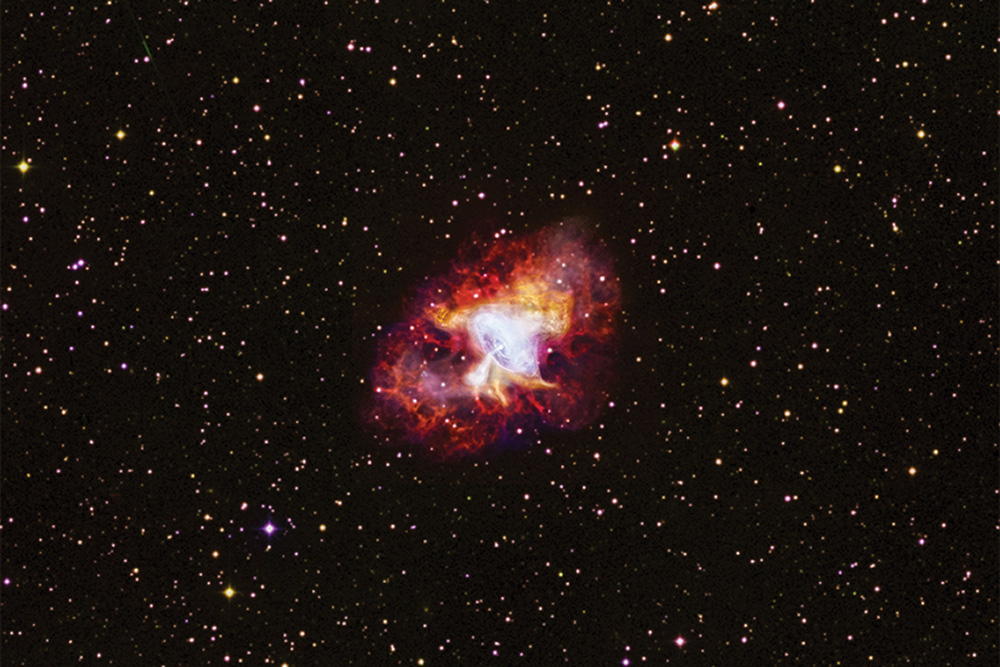
A supernova resulting from the death-collapse of a star between about 10 and 30 times the mass of the Sun is illustrative, as it produces TeV gamma rays both locally and far away. Following the supernova explosion, a roiling shockwave expands outward from the blast site and pushes through gases shed by the star before it went supernova. After perhaps a thousand years of expansion through this gas, the shockwave develops to the point of being able to accelerate cosmic rays above TeV energies. Some of the cosmic rays will then interact with the matter near the supernova to create TeV gamma rays, but most will wander through the Galaxy for tens of millions of years before happening upon a dense cloud, colliding with its particles, and creating TeV gamma rays. In this way, cosmic rays from past supernovae can continue to produce diffuse gamma rays at various locations in our galaxy and beyond, far from the initial explosion.
The same supernova explosion can also generate numerous gamma rays locally because it leaves behind an ultradense, ultramagnetized, and ultrarapidly spinning pulsar at its center. Th e pulsar can accelerate particles, especially lightweight electrons, up to tremendous energies in what’s known as a pulsar wind nebula. Its magnetic fields also spawn low-energy photons through an emission mechanism known as synchrotron radiation, and collisions between the accelerated electrons and the synchrotron photons yield gamma rays emanating from the immediate vicinity of the supernova.
The TeV sky
“We see gamma rays of both kinds, local and diff use,” says Dingus, pointing at the false-color, early-release gammaray sky map from HAWC. “Th is region here”—she sweeps her hand across a broad red swath in the gamma-ray map— “that’s the galactic plane. Here we’re seeing both point sources and diff use gamma-ray light generated by cosmic rays that travel various distances across the Galaxy before colliding with something. And this here”—she points at a large red blob—“is the Crab Pulsar, a distinct compact source nearby.”
Dingus’s gamma-ray sky map was completed when only about 100 of HAWC’s detector tanks, not the full 300, were online. Even so, it reveals the Crab pulsar wind nebula with a tremendous degree of detection significance. With more tanks online and more observing time, HAWC will identify more sources and leapfrog detections by earlier instruments. But one of the real prizes yet to be found in the gamma-ray sky would be a source with the proper energy spectrum—the right mix of higher- and lower-energy photons—to match that of very energetic cosmic rays.
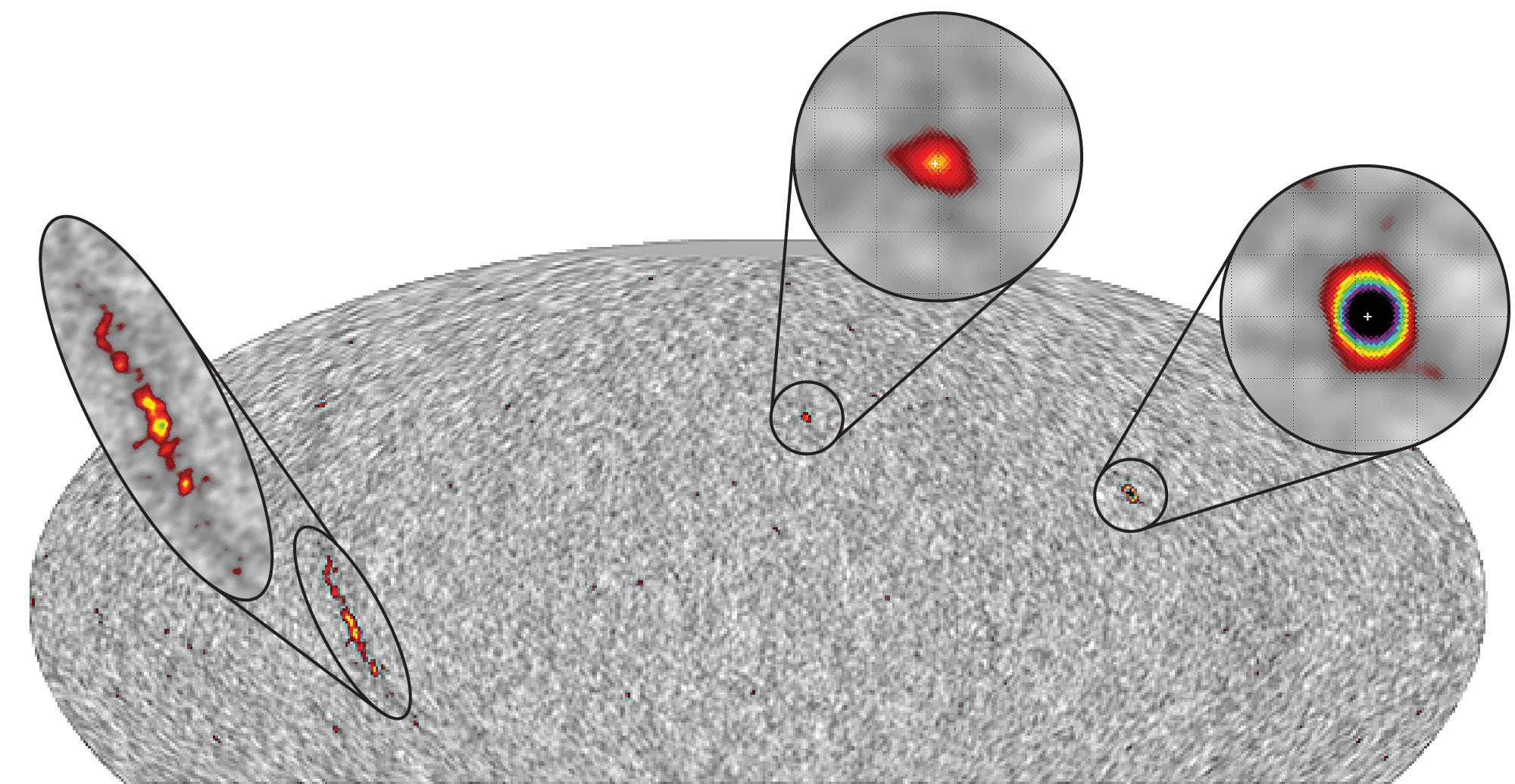
“We’re searching for the smoking gun, the evidence that will firmly identify the origin of the majority of galactic cosmic rays and diffuse gamma rays,” Dingus explains. “Even though we’ve got potential sources like shockwaves and pulsars, we haven’t yet caught one in the act of producing TeV cosmic rays.” Ideally, she hopes to find a gamma-ray source in our galaxy that is producing gamma rays with energies high enough to be consistent with the production of the galactic cosmic rays. This is a challenge because the conditions that could make it possible to observe that link between gamma- and cosmic-ray origins could be very specific, such as the shockwave in an expanding supernova remnant between 10,000 and 12,000 years after the initial explosion. That would provide a window of only 2000 years— very brief in astronomical terms—to identify the culprit. There simply may not be a source of just the right age that’s close enough to detect. However, HAWC will perform the most sensitive search yet for such a source.
Meanwhile, HAWC’s early-release TeV cosmic-ray (not gamma-ray) map may offer clues to other astrophysical mysteries involving cosmic-ray origins. The map shows a mostly uniform distribution of TeV cosmic rays from every which way, as expected. But it also includes three regions of slight excess, each approximately 10 degrees wide, two of which Dingus first encountered with the Milagro water-Cherenkov observatory, HAWC’s predecessor. Scientists do not yet understand the reason for these excesses.
Because local magnetic fields will cause TeV protons to turn with a radius much smaller than the average distance between stars in the Galaxy, there isn’t any viable cosmicray accelerator close enough (associated with our own solar system!) to produce the excesses. They may be indicators of a magnetic focusing effect, although there is no corroborating evidence for that at present. And alternative explanations suggest more exotic mechanisms, such as cosmic rays produced by dark matter, by a new form of quark matter, or by an unknown variety of solar magnetic effect. Thus HAWC may become an instrument for studying not just gamma rays and cosmic rays, but exotic new physics as well.
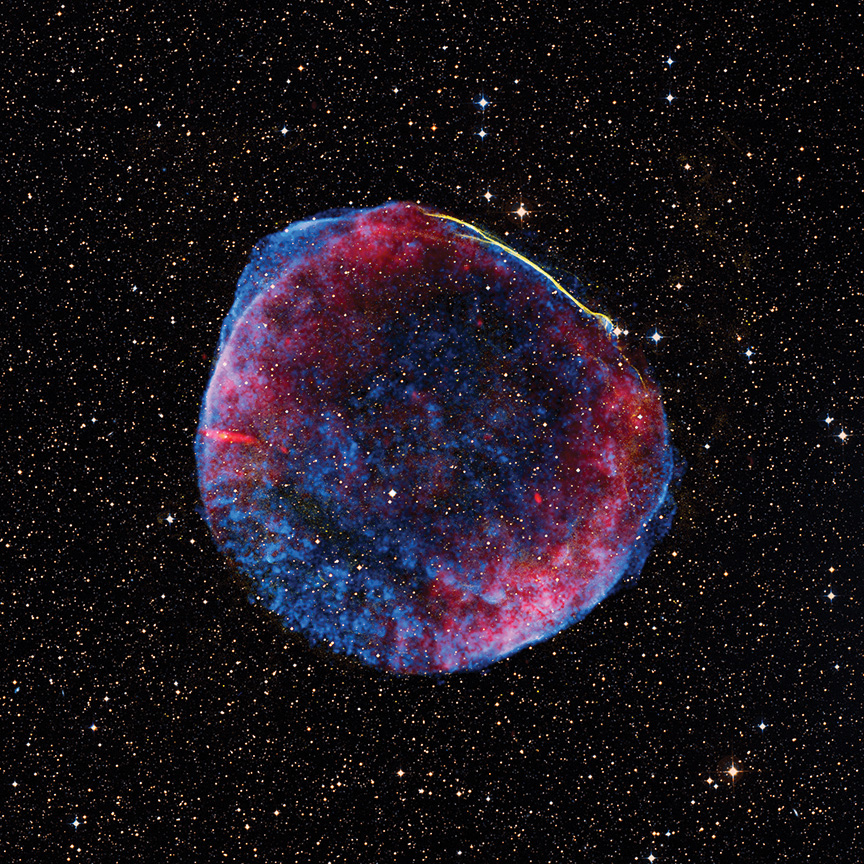
Farther afield
At greater energies, cosmic rays are less affected by magnetic fields. At about 1016 eV, several orders of magnitude above the TeV level (1012 eV), cosmic rays have enough energy to escape the magnetic confinement of the galaxy where they were born. And in intergalactic space, magnetic fields are typically much weaker than they are inside a galaxy. By about 1019 eV, cosmic rays may travel in straight enough lines to point back to a distant extragalactic source, or at least close to it, just as the associated gamma rays do.
Known extragalactic sources capable of accelerating such high-energy cosmic rays and producing such highenergy gamma rays are some of the most energetic objects in the universe. They include so-called starburst galaxies, active galaxies, and gamma-ray bursts. In starburst galaxies, for example, a galaxy-wide episode of new star formation generates a large number of hot, massive, and short-lived stars that quickly run out of fuel and go supernova. The resulting shockwave free-for-all accelerates cosmic rays, ranging up to about 1016 eV, which then interact with galactic gas to produce gamma rays, just as they do in our own galaxy. Indeed, gamma rays from a few starburst galaxies have already been observed.
Active galaxies are believed to accelerate particles to considerably higher energies. Also known as quasars, blazars, radio galaxies, and others, active galaxies are powered by supermassive black holes and are regularly observed with TeV-and-above gamma rays. Two were identified in HAWC’s pre-completion early data release, hinting at a great many more—currently known and unknown—for HAWC to find in the coming years. With luck, HAWC may even be able to identify some of them (or other extragalactic objects) as the accelerators of the very highest-energy cosmic rays.
Cosmic rays exceeding 1020 eV are the most energetic matter ever observed, and their origin is a mystery. They might come from active-galaxy jets, or pulsars, or even something that hasn’t been discovered yet. The best way to find out is to match their arrival directions with known astrophysical sources. Unfortunately, that’s hard to do because they don’t show up very often. Above 1020 eV, they arrive at a rate of only about one particle per square kilometer scanned per century.

In addition, the highest-energy cosmic rays tend to lose energy as they travel through space by colliding with photons from the cosmic microwave background, the residual glow from the big bang. And to a lesser degree, somewhat lower-energy cosmic rays also lose energy in collisions with infrared photons from the extragalactic background light, a blend of radiation from active and inactive galaxies. Both backgrounds are present throughout the universe. That means the highest-energy cosmic rays, and a fraction of those with slightly lower energy as well, must originate relatively nearby if they are to arrive at Earth before colliding away their great energy. That limits the number of possible sources within range.
HAWC is not well suited to overcome the low arrival rates of 1020-eV particles. Even the world’s largest cosmic-ray observatory, operating for over a decade, has yet to accumulate enough of these events to unambiguously identify their sources based on arrival directions. But the same collisions with the universe’s background radiation that limit direct-observation strategies also produce pions, which decay into observable gamma rays. That means HAWC can probe the origins of the universe’s highest-energy particles from a different angle. In so doing, it will also obtain rare insight about the intensity and makeup of the extragalactic background light—insight that will inform other aspects of extragalactic astronomy and cosmology.
Answers ahead
“TeV gamma rays show up in all of the most energetic processes in the universe,” says Dingus. “Want to know about cosmic rays a billion times more energetic than TeV? Look to TeV gamma rays. Want to know about galactic supernova remnants, pulsar wind nebulae, and black-hole binary systems? Look to TeV gamma rays. Or extragalactic sources like blazars and gamma-ray bursts? Again, look to TeV gamma rays.”
Dingus explains by way of example how the HAWC collaboration recently demonstrated that the high-energy component of the most powerful gamma-ray burst yet detected would have been easily observable by HAWC (had HAWC been operational then), making HAWC the first ground-based observatory capable of detecting gamma rays from a gamma-ray burst. HAWC’s detection of a gamma-ray burst would give important clues about the mechanisms that produce these bright flashes. (In earlier research, Dingus was the first to discover that gamma-ray bursts even have a separate high-energy component, somewhat below TeV. Most of their gamma rays are only MeV—millions, not billions or trillions, of eV.) And while gamma-ray bursts are too brief for scientists to aim their telescopes in time to witness the whole thing, HAWC takes in a large chunk of the sky at every instant, allowing it to catch the all-important initial moments of a burst.
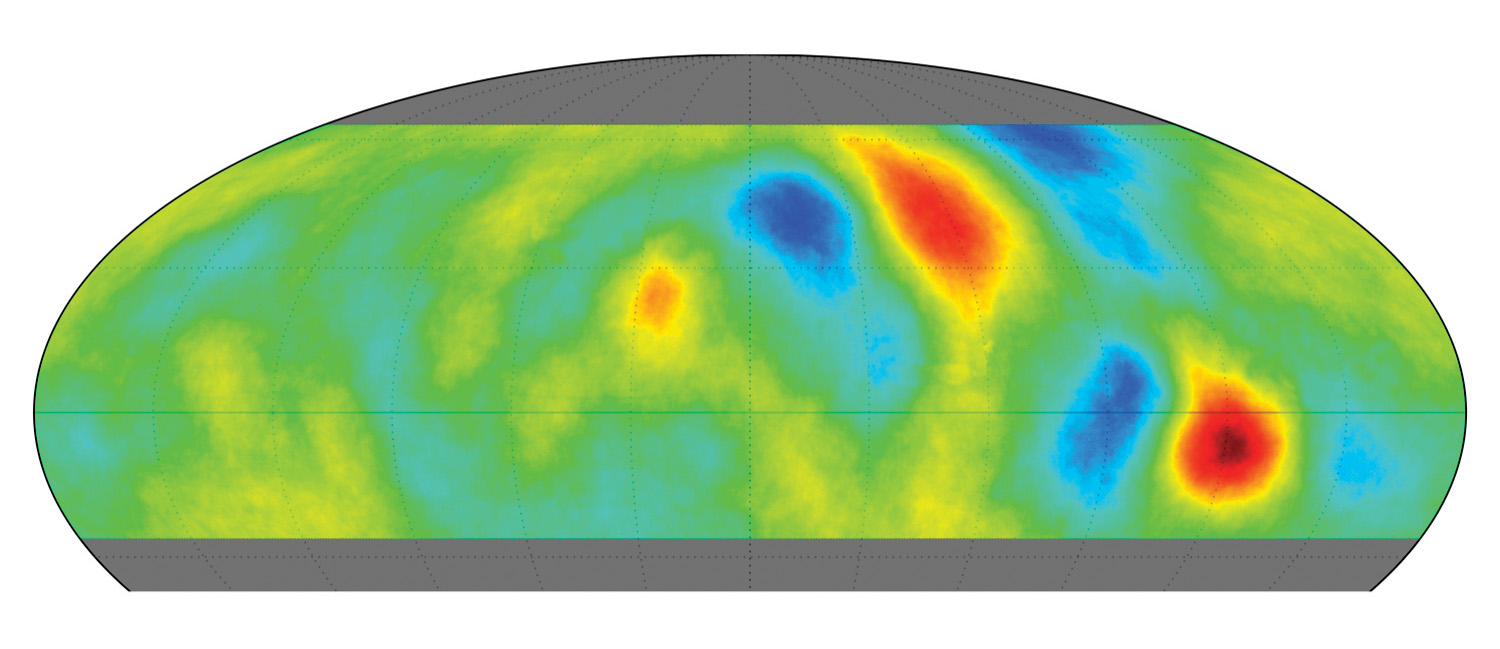
“In fact, gamma-ray bursts aside,” Dingus says, returning to her earlier train of thought, “even if you want to know about exotic new physics, such as microscopic black holes and dark matter, look to TeV gamma rays and HAWC.” Dingus and colleagues recently showed that HAWC is sensitive to gamma-ray signals from either decaying or colliding dark-matter particles with higher masses than can be observed by other dark-matter experiments. They also determined that HAWC has the potential to observe one of the most speculative of exotic objects proposed to inhabit the universe, microscopic black holes.
In 1974, physicist Stephen Hawking published a calculation blending the quantum mechanical and gravitational effects at work at the event horizon of a black hole. It was extraordinary research both because the physics of quantum gravity hadn’t yet been figured out (and still hasn’t) and because his results revealed, quite unexpectedly, that a black hole isn’t entirely black. Rather, it shines faintly with the same spectrum of emission as a hot coal or a star. To be detectable, a black hole would have to be so small as to verge on shining itself right out of existence—a black hole more closely resembling a subatomic particle than a dead star—and even then it would have to be fairly close to our solar system for HAWC to pick it up. But the big bang may well have produced such microscopic black holes, and if one were ever detected, it would represent the first observational confirmation of a remarkable quantum-gravity prediction that Hawking put forth in the same year when Richard Nixon resigned the presidency.
Want to know if he was right? Look to TeV gamma rays.








